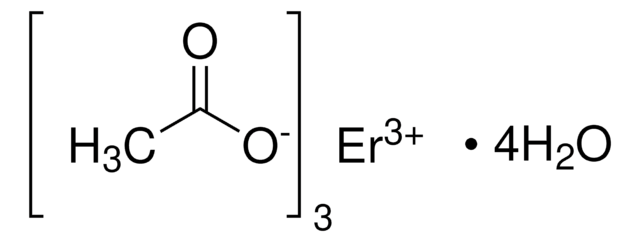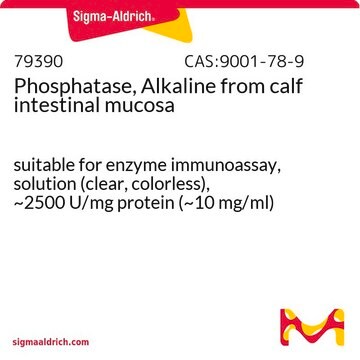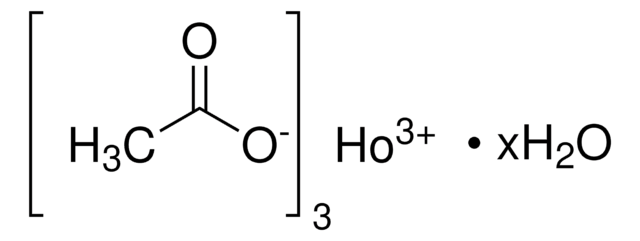930962
Yttrium(III) acetate tetrahydrate
99.99% trace rare earth metals basis
Sinonimo/i:
Acetic acid yttrium(3+) salt, Yttrium triacetate
Autenticatiper visualizzare i prezzi riservati alla tua organizzazione & contrattuali
About This Item
Prodotti consigliati
Livello qualitativo
Saggio
99.99% trace rare earth metals basis
Forma fisica
powder
Impurezze
≤150 ppm trace rare earth metals
≤500 ppm trace metals
Punto di fusione
350 °C (Decomp.)
Solubilità
H2O: soluble (lit.)
Densità
1.5 g/cm3
Descrizione generale
Yttrium acetate tetrahydrate is a white, crystalline salt. The salt is soluble in water and mineral acids as well as solutions, such as methoxyethanol with diethylenetriamine, that complex with the Y3+ cations.
Applicazioni
Yttrium acetate is a common reactant in the synthesis of yttrium compounds including yttrium oxides and yttrium fluorides. Yttrium acetate is particularly useful because of its solubility in and low thermal decomposition temperature, which make it attractive for hydrothermal reactions and co-precipitation processing before calcination.
A major application of high-purity yttrium acetate is in the synthesis of sodium yttrium fluoride (NaYF4) nanoparticles. Typically, in these syntheses, yttrium acetate is mixed with oleic acid in octadecene and heated to form Y(oleate)3, which is reacted with ammonium fluoride and sodium hydroxide in methanol at modest temperatures (e.g. 50 C) to form NaYF4 nanoparticles. This synthesis offers great control over particle size and crystallinity and allows for easy incorporation rare-earth metal dopants.
Lanthanide-doped NaYF4 nanoparticles are one of the most studied materials for up conversion. These nanoparticles, which can convert two photons of near-infrared (NIR) light into visible light, have important in-vivo applications because of the deep tissue penetration abilities of NIR. For example, these nanoparticles have been used for in-vivo Zn2+ optical sensing, in-vivo ratiometric sensing of lymphatic inflammation,, and in-vivo sensing of peroxynitrite.
A major application of high-purity yttrium acetate is in the synthesis of sodium yttrium fluoride (NaYF4) nanoparticles. Typically, in these syntheses, yttrium acetate is mixed with oleic acid in octadecene and heated to form Y(oleate)3, which is reacted with ammonium fluoride and sodium hydroxide in methanol at modest temperatures (e.g. 50 C) to form NaYF4 nanoparticles. This synthesis offers great control over particle size and crystallinity and allows for easy incorporation rare-earth metal dopants.
Lanthanide-doped NaYF4 nanoparticles are one of the most studied materials for up conversion. These nanoparticles, which can convert two photons of near-infrared (NIR) light into visible light, have important in-vivo applications because of the deep tissue penetration abilities of NIR. For example, these nanoparticles have been used for in-vivo Zn2+ optical sensing, in-vivo ratiometric sensing of lymphatic inflammation,, and in-vivo sensing of peroxynitrite.
Codice della classe di stoccaggio
11 - Combustible Solids
Classe di pericolosità dell'acqua (WGK)
WGK 3
Punto d’infiammabilità (°F)
Not applicable
Punto d’infiammabilità (°C)
Not applicable
Certificati d'analisi (COA)
Cerca il Certificati d'analisi (COA) digitando il numero di lotto/batch corrispondente. I numeri di lotto o di batch sono stampati sull'etichetta dei prodotti dopo la parola ‘Lotto’ o ‘Batch’.
Possiedi già questo prodotto?
I documenti relativi ai prodotti acquistati recentemente sono disponibili nell’Archivio dei documenti.
Shangfeng Wang et al.
Nano letters, 19(4), 2418-2427 (2019-03-19)
Quantitatively imaging the spatiotemporal distribution of biological events in living organisms is essential to understand fundamental biological processes. Self-calibrating ratiometric fluorescent probes enable accurate and reliable imaging and sensing, but conventional probes using wavelength of 400-900 nm suffer from extremely
Two-Photon Upconversion Laser (Scanning and Wide-Field) Microscopy Using Ln3+-Doped NaYF4 Upconverting Nanocrystals: A Critical Evaluation of their Performance and Potential in Bioimaging.
Pichaandi J, et al.
The Journal of Physical Chemistry C, 115, 19054-19064 (2011)
Zhenglin Yang et al.
Journal of the American Chemical Society, 140(50), 17656-17665 (2018-11-15)
Spatial and temporal distributions of metal ions in vitro and in vivo are crucial in our understanding of the roles of metal ions in biological systems, and yet there is a very limited number of methods to probe metal ions
Juanjuan Peng et al.
Angewandte Chemie (International ed. in English), 56(15), 4165-4169 (2017-03-16)
Drug toxicity is a long-standing concern of modern medicine. A typical anti-pain/fever drug paracetamol often causes hepatotoxicity due to peroxynitrite ONOO- . Conventional blood tests fail to offer real-time unambiguous visualization of such hepatotoxicity in vivo. Here we report a luminescent
Hard Proof of the NaYF4/NaGdF4 Nanocrystal Core/Shell Structure.
Abel K A, et al.
Journal of the American Chemical Society, 131, 14644-14645 (2009)
Il team dei nostri ricercatori vanta grande esperienza in tutte le aree della ricerca quali Life Science, scienza dei materiali, sintesi chimica, cromatografia, discipline analitiche, ecc..
Contatta l'Assistenza Tecnica.








